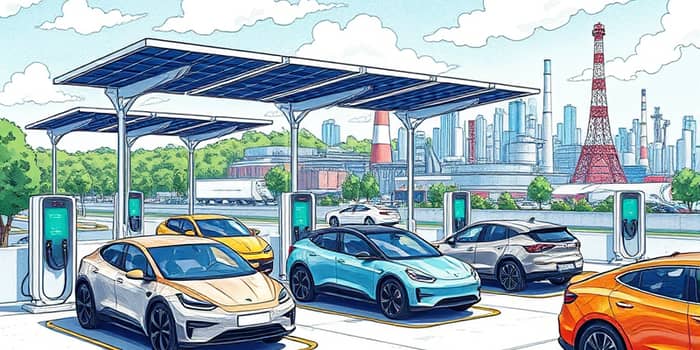
The automotive world is witnessing a profound transformation as electric vehicles (EVs) surge from niche products to mainstream mobility solutions.
Fueled by government support, technological breakthroughs, and shifting consumer priorities, the industry is accelerating toward a cleaner, more efficient future.
Once a novelty, EVs now occupy a pivotal role in the automotive industry, with sales climbing at an unprecedented pace. Analysts project that by 2025 global EV sales will reach 85 million units worldwide, representing more than over 20% of global vehicle sales. In China alone, EVs are forecast to account for 35% of new car purchases in 2025 and to dominate over 60% of global EV transactions.
Looking even further ahead, by 2040 EVs could constitute approximately 65% of all new passenger vehicles sold globally, with Europe potentially achieving full EV penetration by 2035 under the EU’s “Fit for 55” package. North America is catching up, buoyed by federal and state measures, and expects to reach close to 60% EV share by 2040.
At the core of this rapid adoption are expanded federal tax credits and subsidies that lower the cost barrier for consumers and businesses alike. In the United States, the Inflation Reduction Act introduced substantial tax credits for new and used EV purchases, alongside grants for charging infrastructure installations.
Many countries worldwide have followed suit, deploying tax credits, grants, and subsidies to encourage both vehicle acquisition and charger deployment. Nations such as Germany, France, and the Netherlands offer eCredits and direct funding to Charge Point Operators, leading to a concentrated network of stations in urban centers.
Some regions are even considering VAT reductions on public charging to match home charging rates, ensuring that all drivers can benefit from fair pricing and reliable access. Utility incentives and state-level programs further supplement these national efforts, creating a multilayered support system for EV expansion.
Automakers are racing to unveil new EV lineups across every segment and price point. Scout Motors, for example, returns with an all-electric Traveler SUV and a Terra Truck, targeting both lifestyle and commercial buyers. Legacy brands such as Ford, GM, Volkswagen, and Toyota have committed billions to re-tool plants for EV production and to co-develop batteries with technology partners.
Battery chemistry is improving, enabling faster charging and increased driving range. Vehicles now achieve 300+ miles on a single charge, and next-generation solid-state batteries promise even greater energy density and safety. Meanwhile, performance EVs in sports segments showcase instant torque and agile handling, further dispelling myths about electric vehicle capabilities.
Motorsports are also electrifying: Formula E races in major cities highlight sustainable racing technology, and Formula 1’s shift to hybrid engines and sustainable fuels by 2026 demonstrates an industry-wide commitment to cleaner motorsport.
The shift to EVs reverberates through automotive supply chains. Manufacturers are investing in localized battery manufacturing and supply to reduce dependencies on long-haul logistics for critical minerals such as lithium, cobalt, and nickel. Joint ventures between automakers and mining firms are charting new territory in raw material sourcing.
Repair and service networks are evolving too. With fewer moving parts, EVs require less routine maintenance but demand specialized technicians for high-voltage systems. Training programs and certification standards are proliferating, ensuring that service centers can safely handle battery diagnostics and software updates.
For consumers, the ownership experience is transforming. Remote software updates add features and optimize performance over time, while warranty packages often cover battery health for eight years or more. Retail models are shifting away from dealerships toward direct-to-consumer sales, supported by virtual showrooms and home delivery.
A robust charging network is essential to overcoming range anxiety. By 2025, governments and private investors plan to deploy tens of thousands of new fast-charging stations worldwide. Standards bodies are working toward universal connectors and interoperable billing systems, making cross-border EV travel seamless.
Utility companies are increasingly partnering with automakers and states to integrate charging with the grid. Vehicle-to-grid (V2G) technologies are under trial, allowing EVs to act as mobile energy storage during peak demand. Renewable energy sources, such as solar and wind, power many of these new stations, aligning infrastructure growth with sustainability goals.
The numbers speak volumes: global EV fleet size is expected to reach 95–105 million by 2030 and surge to 585–823 million by 2050. In 2023, the EV market was valued at $457.6 billion, with an annual growth rate surpassing 17%. EV share of the auto market climbed from 5.6% in mid-2022 to more than 20% of new vehicle sales by 2025.
Revenue streams extend beyond vehicle sales to include charging services, software subscriptions, and battery leasing programs. Many OEMs are bundling maintenance and energy plans into subscription packages, creating new recurring income models.
Despite remarkable progress, challenges remain. Policy continuity is not guaranteed in every region, exposing EV growth to electoral shifts and budget debates. Supply chain bottlenecks for key minerals can disrupt production schedules and push costs upward.
Consumers in markets with limited incentives or sparse charging infrastructure may adopt a “wait-and-see” approach, preferring to delay purchases until networks mature. To counter these hesitations, manufacturers and governments are collaborating on awareness campaigns and test-drive initiatives.
Battery recycling and second-life uses are emerging priorities. As early-generation EV batteries reach end of life, circular economy practices must scale to reclaim critical materials and repurpose cells for energy storage applications.
The auto sector’s pivot to EVs is no longer a distant vision—it is a tangible reality shaped by bold policies, technological advancement, and consumer demand. From sprawling charging networks to innovative battery breakthroughs, the ecosystem supporting electric mobility is expanding rapidly.
By embracing multilayered policy incentives and infrastructure investment, governments and industry players are unlocking a new era of sustainable transportation. As the world accelerates toward 2040 and beyond, electric vehicles promise to redefine mobility, reduce emissions, and power the global economy with cleaner energy.
References













